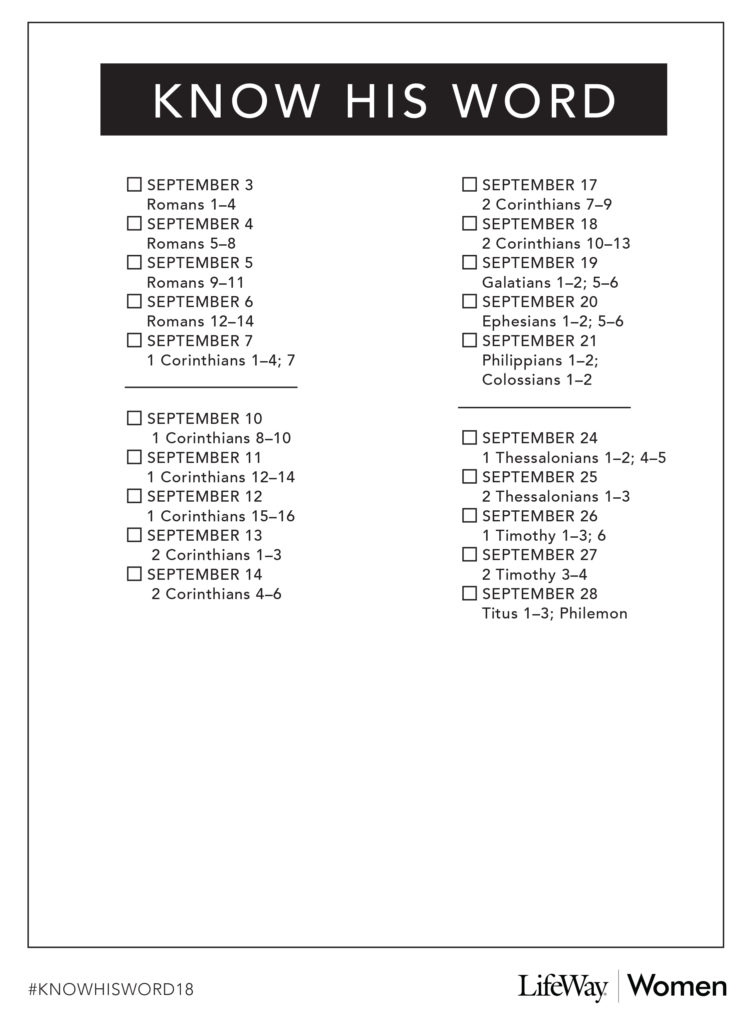
As we strive to Know His Word more deeply in 2018, we’ll be reading the Bible together in sections. Our hope is that together we will see how each book of the Bible fits into the overarching story of Scripture. On the first day of each month, we’ll walk through a new biblical genre together. This month, we’ll be looking at the Letters of Paul.
This past month as we’ve read through Acts, we’ve witnessed the Holy Spirit at work in the early church, watched Christian community point the watching world to Christ through its love, and journeyed with Paul on some of his travels to share the gospel. Now we progress to Paul’s letters, his pastoral pursuit of God’s people – offering everything from doctrinal direction to relational correction as needed.
As we dive into Paul’s letters, it will help us to understand a bit more about the cultural context. From a young age, we’re taught how to craft a letter – begin with Dear [recipient’s name], add the date, compose the main message of the letter, and close with some sort of greeting & signature – it’s almost second nature to assume that letters have always been composed in the same way. But a quick glimpse at the Letters of Paul in the Bible shows us that folks in New Testament times composed letters a bit differently. A little insight into their world will help us as we study Paul’s letters.
Here are a few consistent components of New Testament letter writing to look for as you read this month:
- Opening: Most letters written during this time lead with the name of the intended audience, the person writing the letter, and a statement of thanksgiving to God plus a prayer for the recipient’s well-being. This inclusion of thanksgiving and supplication was actually used by the pagan cultures of the day too (of course, they were asking pagan gods to bless them), but you’ll notice that Paul offers them with a theological focus, often asking God to bless his readers with spiritual health instead of physical or financial prospering (as pagan cultures were wont to request).
- Body of the Message
- Closing: Letters were usually closed with greetings to specific people – think, something like “please send my love to Uncle Joe, tell him I miss him.” This was especially prominent when Paul wrote letters to larger groups of people, for example church bodies.
- Signature: Oftentimes a secretary or scribe, someone to whom the author would dictate the message, actually wrote these letters down. In that case, the author of the letter would many times sign the bottom of the correspondence himself, or include a brief note of authentication basically saying, the scribe wrote it, but I attest to the truth of this message – it’s from me, this is what I said. This accounts for Paul’s statement in Galatians 6:11, “see with what large letters I am writing to you with my own hand.” The implication: up until that point in the letter the scribe had written the content, and now Paul was finishing it out. Sometimes the writer didn’t explicitly state that the letter was dictated because a change in handwriting made it evident that two different people had contributed to the work. That tidbit doesn’t help us in the biblical account because we can’t see the original writing, but it’s good to be aware of the possibility if you notice a seemingly abrupt change in voice or tone while you’re reading.
As you read through each letter, pay special attention to the context of the original audience and the message Paul is trying to communicate to them, with an eye for the differences between their culture and ours. Because these are letters, it may help you to read the entire book through in one sitting to grasp the flow and progression of the overarching discussion before you focus on a smaller, more specific passage. Helpful tip: if you get lost or confused in your reading of the text, you can always reference the introduction or conclusion of each letter as they usually summarize the main message being conveyed.
It’s nearly impossible to adequately summarize the contribution that of all of Paul’s letters have had on Christendom, let alone offer them in a neat, nutshell teaching. In the month to come, we’ll be reading: Romans, 1 & 2 Corinthians, Galatians, Ephesians, Philippians, Colossians, 1 & 2 Thessalonians, 1 & 2 Timothy, Titus, and Philemon.
In these letters, we’ll grapple with topics such as righteousness, justification before God, sanctification, Christian doctrine, church administration, persecution, authentic Christian life and ministry, work ethic, godly relationships, the Lordship of Christ, the role of the Holy Spirit in our lives, the second coming of Jesus, social justice, slavery, and our true identities in Christ.
So many of these letters inform our not only our daily living but our doctrinal foundations. Let’s dive into these letters from the apostle Paul and allow them to usher us into right theology and godly living.
Here’s a PDF of the September reading plan to print!
We would love to hear what you’re learning as we read through His Word together. Share on social media with the hashtag #KnowHisWord18, so we can learn together! We’ve also included an image below, featuring a verse we’ll read this month, perfect for Instagram.



